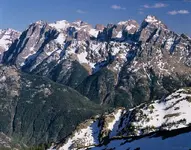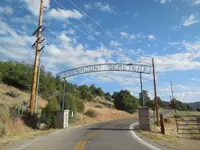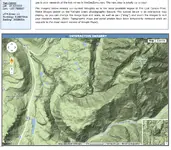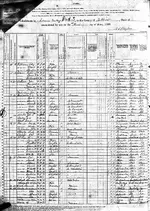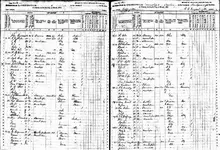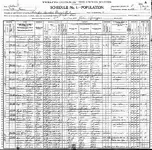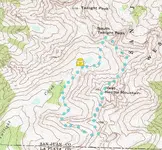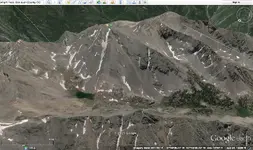Before he died Carson confided in his family that his strike was on the north face of the West Needle Mountains. He also told them he did not have to work hard to recover the ore, and that it was a surface outcropping of sugar brown quartz loaded with free gold. As well he indicated it was far above his main camp at the foot of the mountains, well above tree line. He said when he was working at the site he stayed in a crude shelter under a rock overhang with some poles leaning against it, and when he left he always made sure the vein was well covered. He said it was inaccessible to pack animals entirely as well.
After Carson died people began looking for signs of where he had been working in the area. A couple of his campsites were located, one of the most extensive being found at timberline on Twilight creek, where grazing was excellent for his pack animals, and he only had to build a crude gate in the only downhill exist to prevent them from wandering off. As sdcfia posted, John Edwards found samples of float that matched Carson's ore on Twilight Creek. He was a professional prospector, and also an avid fisherman. While on fishing trips on the east bank of the Lime River he would explore the Twilight watershed extensively searching for signs of Carson's mine. One year he found a cache on a small ledge of dynamite and steel drills presumably left by Carson, up a little side canyon high up on the Twilight Creek watershed, very near Carson's main base camp. But he soon gave up after not finding anything further, and it was extremely hard to access the area he needed to search.
Mike Powell, a local stockman, also found float of the same kind much lower in the same area of Twilight Creek. The most memorable sample was about the size of a man's fist and assayed at the time at several thousand dollars per ton. Unfortunately he was not experienced with prospecting and only searched the area he found the fist size ore sample, not understanding it had come from much higher in the watershed.
But the most interesting find was made by a sheep herder named Juan Quintana while working for J. J."Jack" McCormick, a sheepman from Durango. That year Jack established a sheep camp at the little basin at the head of Twilight, very near where Carson had his main base camp. While bored and hiking around the area, Quintana discovered the vein Carson had been working, including the crude pole shelter, an old fire pit, and rusted tin cans in a trash site. He took some samples from the vein back to the camp Jack had set up for him to tend sheep from, and when Jack came to visit to make sure all was well with his heard and Quintana was managing things well, he saw the ore samples. Of course he became quite excited and demanded his employee tell him where he had found the ore. But Quintana was afraid he would be killed if he revealed his secret, and was very superstitious, which was quite common with Mexican born sheepherders in the area at the time. Quintana took all the ore samples but the leanest one and buried them under a large spruce tree nearby during the night. Then when Jack returned to Durango to have the remaining ore sample assayed, Quintana returned to the vein site and covered it completely with dirt, and removed the poles from the shelter and threw them down the slope and scattering them completely.
The lean ore sample Jack returned to town with assayed at over $500 a ton. But Quintana would not reveal the place he found it, no matter what Jack tried to induce him with to reveal the location. Around ten years later in 1932 when Quintana was working for another outfit run by a guy named Corny, he started talking about what he had found long ago. Corny was a kind and considerate man who respected the sheepherder and treated him much better than Jack had. By this time he was an old man, and though he tried to describe the exact location to Corny, he could not describe it well enough so that Corny could figure out the location. He promised to lead Corny to the exact spot the following spring, as winter had already set in. But he died that winter from pneumonia, and the last living link to the Carson Mine was lost.



